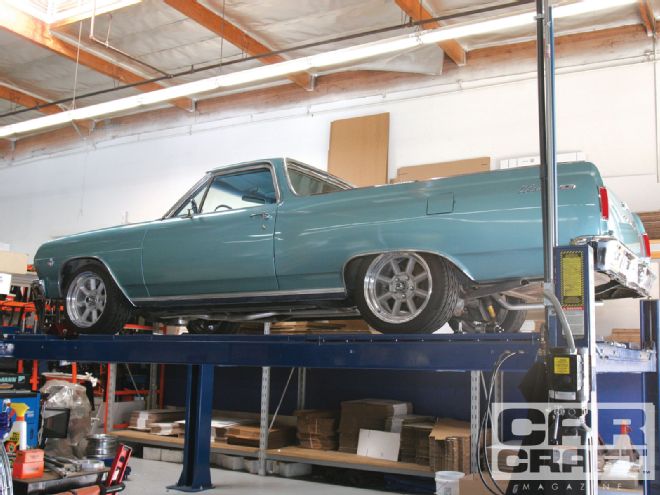
Your stock Chevelle doesn't handle. Don't get mad at us; the factory wanted it that way. To make these cars easy to drive and stable, GM dialed in positive camber gain and only small amounts of caster into the suspension geometry. The -1 to 1 degree of caster gives you little or no road feel, made worse by power steering, and the positive camber gain generates understeer when you try to speed through a corner. It was good for the public and bad for the car guy.
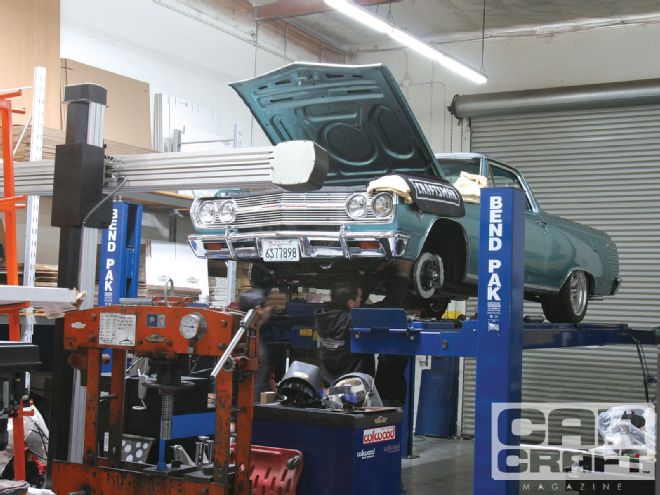 Doug Norrdin started Global West as a company that installed suspensions and tuned Formula cars in the late '70s. As the company grew, it got away from the installation side of the business and focused on R&D. Today, Global West is back in the parts installation business and can help you dial in your car. We stopped by the facility in San Bernardino, California, to check out this install.
Doug Norrdin started Global West as a company that installed suspensions and tuned Formula cars in the late '70s. As the company grew, it got away from the installation side of the business and focused on R&D. Today, Global West is back in the parts installation business and can help you dial in your car. We stopped by the facility in San Bernardino, California, to check out this install.
For the fix, we went to Global West, where Doug Nor-rdin showed us the parts that both solve those issues and create room for 17x9.5-inch wheels and 275/40ZR17 Toyo Proxes 4 high-performance tires in the front and rear of the car. The result is more aggressive handling, lower ride height, more road feel, and a lot more control. Best of all, you don't have to spend 10 grand on your suspension to compete with the fast cars. The Global West pieces cost about $2,500 total and can be bolted on in one weekend in your garage.
According to Norrdin, a mean-handling Chevelle needs 5.5 to 6 degrees of positive caster and at least 2 degrees of negative camber gain to work. These angles are measured in relation to the ball joints and controlled by the position control arms. Global West's G-plus package builds this caster into the control arm and fixes as much of the positive camber gain possible using the stock height spindle.
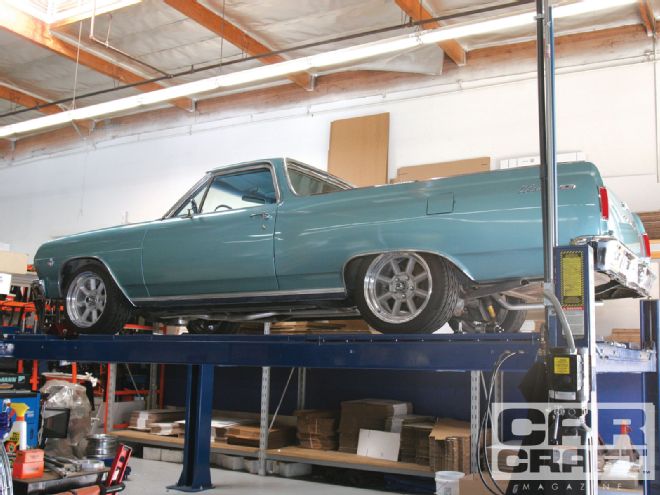 This '65 El Camino was perfect for the suspension upgrade. It had stock suspension with drum brakes, making it a bit scary on L.A. freeways. Note the 4x4 ride height in the front.
This '65 El Camino was perfect for the suspension upgrade. It had stock suspension with drum brakes, making it a bit scary on L.A. freeways. Note the 4x4 ride height in the front.
Let's say you have a street car where there is zero caster; you might see 2 degrees or more of positive camber gain on turn-in, rolling the tire away from the center of the vehicle and the optimum contact patch of the tire. The design of the G-plus control arm increases negative camber on initial turn-in. The combination of the G-plus arm's geometry and the inclination of the spindle keeps the tire contact patch in the negative camber zone even though you have positive camber gain. With the G-plus, you are not going to get killer negative camber gain without dialing in a bunch of static negative camber, but you will get street manners and better tire life.
To eliminate positive camber gain entirely, you'll need the Negative Roll System. It requires a taller spindle that allows you to run little static camber and nets you aggressive negative camber gain when you turn the car in. This system will cost more, and unlike the G-plus system that allows you to lower the car as far as you want, the ride height needs to be within an inch or so of stock. Don't get us wrong-both systems will be a lot better than your stock parts, but you need to know which system is right for you.
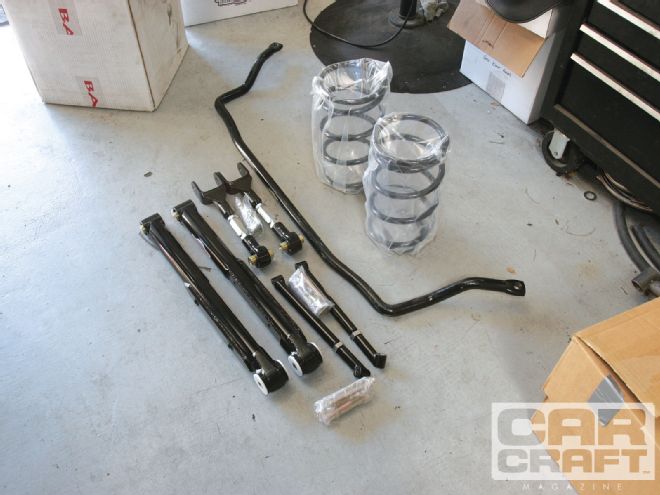 The rear suspension package has rear upper adjustable control arms, rear lower tubular control arms, rear frame supports, and hardware. Norrdin recommends using more spring and less sway bar for suspension tuning. In this case, the front sway bar (shown) is 1 1/8 inches, and we will not use a rear bar at this time. The springs are S63 rated at 120 pounds and drop the rear 1 1/4 inches.
The rear suspension package has rear upper adjustable control arms, rear lower tubular control arms, rear frame supports, and hardware. Norrdin recommends using more spring and less sway bar for suspension tuning. In this case, the front sway bar (shown) is 1 1/8 inches, and we will not use a rear bar at this time. The springs are S63 rated at 120 pounds and drop the rear 1 1/4 inches.
This stuff fixes all the problems inherent with a 45-year-old car. Instead of standard rubber bushings that deflect, creak, and squeak, all the Global West parts come with Del-a-lum bushings. Here is the basic pitch: Rubber bushings deflect and have a tendency to offset and distort. This is called cold flow and causes alignment problems and deficiency in handling. With the Del-a-lum bushings, you are going to get longevity in addition to the aluminum's unwillingness to distort your suspension angles or bind, causing mysterious and frustrating handling problems.
In the rear, the G-plus package does a couple of important things. The adjustable upper control arms allow you to set or reset your pinion angle without removing the arm from the car. Drag racers know that the pinion angle is key to getting the car out of the hole at the dragstrip, and the same is true for getting it out of a corner. The uppers also control the lateral movement of the differential that blows out the stock bushings. The adjustable uppers use a spherical bearing that allows the rearend to move without binding. The lowers use a Del-a-lum bushing on the differential side to control lateral movement and a spherical bearing on the frame side, so there is no bind as the bars travel through their arc. There is also a set of rear frame supports that ties the control arm to the factory crossmember to stabilize the upper mounts and prevent them from being broken when you nail the gas pedal. All these things add up to a rearend that doesn't bind or wander. Stability here correlates to a controllable car in the corners.
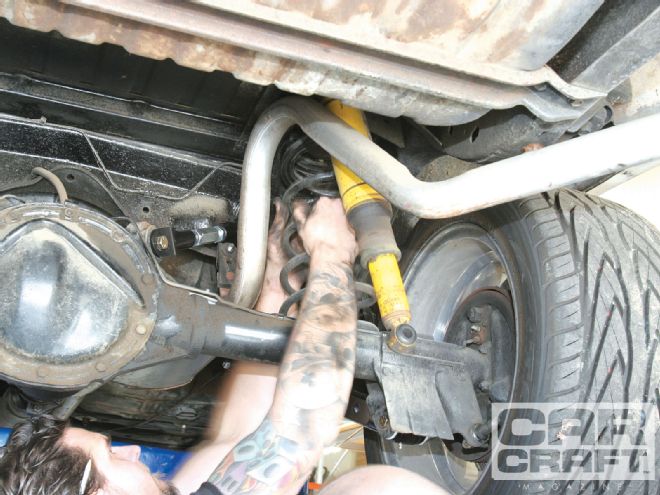 All you need to do is unbolt the shocks and jack the frame until the springs slide out. We reused the factory lower spring perches.
All you need to do is unbolt the shocks and jack the frame until the springs slide out. We reused the factory lower spring perches.
The last two bits of the puzzle are the springs and the shocks that control them. Forget cutting or heating your stock springs, when a pair of good springs is about $150. Factory springs are designed to give you a cushy ride. The downside is a lot of body roll as the springs compress in a corner. Performance springs that are too aggressive give you little or no body roll and a stiff, jarring ride. The springs we used have 120-pound rates that lower the car 1 inch in the front and 11/4 inches in the rear. They retain a bit of the street feel without the harshness of an overly aggressive road race spring. These springs work well with a 11/8-inch sway bar.
We didn't install shocks on the car in this story because of the large role they play in the tuning of the suspension and the number of manufacturers that supply them. Norrdin advised us to buy either a single- or double-adjustable shock. His reasoning suggests that installing a good suspension and then not having a way to adjust how it performs doesn't make sense. We agree. You don't have to get the ultradollar double-adjustable shocks if you aren't going to do any fine-tuning or serious road racing, but at least go for the single-adjustable type. If you are going to do more than just try to look cool, get the good shocks.
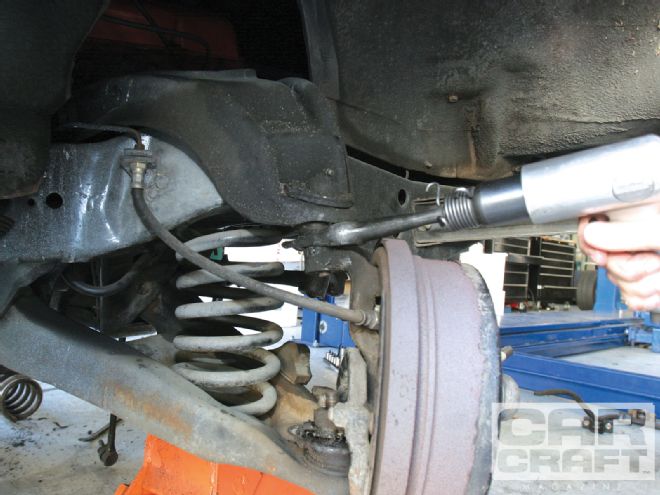 Since we were essentially replacing everything up front, we relied on the violence of the air hammer with the pickle fork attachment without caring that it might destroy the ball joints.
Since we were essentially replacing everything up front, we relied on the violence of the air hammer with the pickle fork attachment without caring that it might destroy the ball joints.
The parts and prices can be fine-tuned for each individual user and discounted as a kit. Therefore, the parts and prices for this story might be different for you, as will the experience.
Caster, Camber, and Toe
Caster: Viewed from the side of the car, this is the angular difference between the imaginary line drawn through the center line of the wheel and the imaginary line drawn through the upper and lower ball joints.
Camber: Viewed from the front of the car, this is the difference between the top and bottom of the wheel as it is tilted in, toward the car or out, away from the car.
Toe: As viewed from top of the car, this is the difference in distance between the front edge of each tire as it points in, toward the centerline or out, away from the centerline of the car.
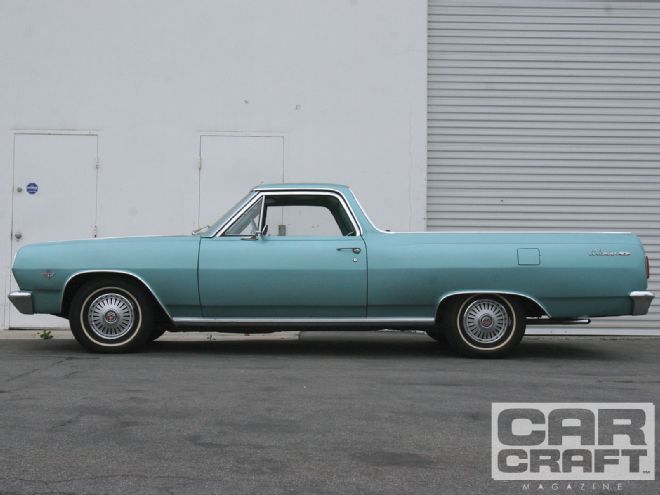 Here is the before photo with the stock suspension wheels and tires. We normally would run a before test on a track day, but there were way too many unsafe parts to try it. We will dial the car at the track and show you how to club that guy in the Corvette like a baby fur seal.
Here is the before photo with the stock suspension wheels and tires. We normally would run a before test on a track day, but there were way too many unsafe parts to try it. We will dial the car at the track and show you how to club that guy in the Corvette like a baby fur seal.
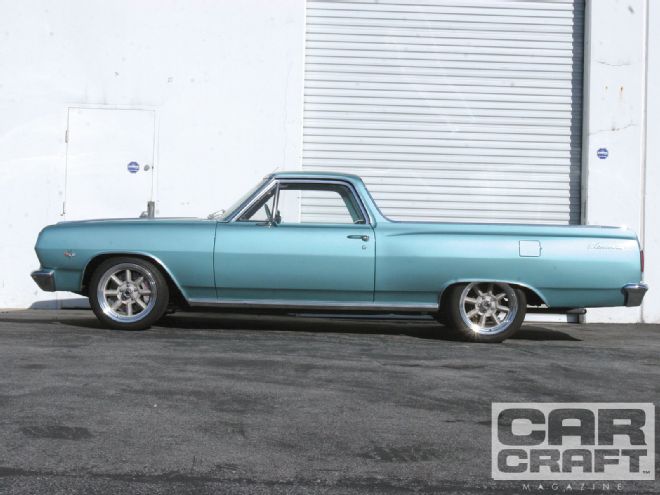 This is the El Camino after the suspension, wheels, and tires. It's hard to describe the improvement in handling with words, but you can see the improvement in looks.
This is the El Camino after the suspension, wheels, and tires. It's hard to describe the improvement in handling with words, but you can see the improvement in looks.
PARTS LIST DESCRIPTION PN SOURCE PRICE Pro Plus 13-inch front brakes 4301336S Baer $2,145.00 G-plus upper control arms CTA-42AP Global West 693.14 G-plus lower control arms CTA-42L Global West 787.27 Front springs S-13 Global West 166.18 Rear springs S-60 Global West 144.02 Rear upper control arm kit TBC-47 Global West 316.85 Rear lower tubular control arm kit TCB-4 Global West 404.90 Rear frame supports TS-47 Global West 137.72 Sway bar SB-883 Global West 229.30 17x9.5 wheels (6-inch back) V48 Vintage Wheel Works 389.75 each Proxes 4 tires 275/40ZR17 Toyo Tires *124.98 each *Tiresdirect.net